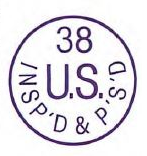Federally Inspected
Federally inspected facilities are overseen by the Department of

Stamp used to indicate that carcass has been federally inspected. Stamp is placed on primal cuts, but not every retail cut.
Agriculture’s (USDA) Food Safety Inspection Service (FSIS). They are required by law to provide inspection for all federally-regulated processing facilities. Without the inspector present, the establishment cannot process cattle, hogs, or poultry. To ensure meat safety in all federally inspected plants USDA inspectors are required to inspect all live animals prior to harvest (at the slaughter facility) and perform additional inspections post-harvest. If the carcass fails to pass the USDA inspections the carcass is condemned and cannot enter the food supply. If the carcass passes USDA inspection the carcass is stamped with a non-toxic ink stamp, demonstrating that the carcass has passed USDA inspections.
Can I sell my meat?
Yes, USDA slaughtered animals can be sold to restaurants, grocery store meat departments, specialty meat markets, and sold retail on-site.
State Inspected
State inspection programs operate under a cooperative agreement with the USDA Food Safety and Inspection services. The facilities in states with state inspection can choose between FSIS or state inspection. The difference between the two approaches is that state inspection programs only allow for meat processed in these facilities to be sold within the state- “intrastate”- while FSIS inspected facilities can export meat to other states, or “interstate.” In California, state inspected slaughter facilities are under state guidelines.
Can I sell my meat?
No, meat processed at these locations cannot be sold and can only be used by the owner, owner’s family, non-paying guests and employees. However, under AB 2114 ranchers can now sell costumers a whole or partial steer. This type of transaction is possible if a costumer purchases the live animal directly from the rancher prior to slaughter and the consumer pays the harvesting facility for harvesting and cut and wrap services directly (
See cow-share program for more information).
Custom Exempt Facilities
Custom-exempt facilities are not inspected on a daily basis, nor are the animals and meat products handled there, however the buildings and equipment are inspected for proper sanitation and maintenance. Meat products processed at these facilities can only be used by the owner of the animal.
Can I sell my meat?
No, meat at these facilities cannot be sold or donated to anyone else. However, under AB 2114 ranchers can now sell costumers a whole or partial steer. This type of transaction is possible if a costumer purchases the live animal directly from the rancher prior to slaughter and the consumer pays the harvesting facility for harvesting and cut and wrap services directly (
See cow-share program for more information).
On Farm Harvesting and Processing
There is no oversight for harvesting and processing livestock at home. However, meat processed at home is not available for resale.
Can I sell my meat?
No, meat can only be consumed by owner.






